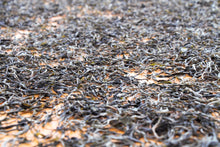
Mang Fei is one of four famous tea production areas in Lincang, Yunnan of China.
Tea is made from natural farming garden from high mountain. After aging in Malaysia since 2015, tea is well-matured with full body drinking sensation, with a lingering nutty note and a hint of sugar cane flavor.
Why we always like to buy tea from Lincang?
Generally, the tea production area located at south Yunnan such as Bu Lang Shan, Yiwu and Lao Bang Zhang are historically very famous. Due to high market demand, price of the tea from these areas are very expensive. Recently, the road condition to access these production sites has been drastically improved too. As the road condition improves the general public is able to access tea production areas and thus further pushing up the price of tea. In Yunnan, it always happened that when the price of tea starts increasing, the farmer changes their traditional agricultural practice. In South Yunnan, it is very hard to find naturally grown tea tree that uses no fertilizer. Even if we do find it, the price is super high.
Mang Fei is one of the four famous origins in Lincang
There are four well-known places in Lincang, and they are Bing Dao, Xi Gui, Ma An Shan and Mang Fei. These four places mentioned above are famous among Chinese Pu-erh tea lovers. Mang Fei is a small village that is very close to the Myanmar border. In Chinese, Mang Fei means Busy Lung. I believe the name of this village originated from the pronunciation used by the local minority tribes. Of course there are many other small villages that produce good quality tea as well but aren't as famous as the ones mentioned.
Distinctive Character: Strong Body
Mang Fei tea is renowned for its distinctive feature—a strong, bold body. This characteristic can be attributed to the unique geography of the village. A small river runs through Mang Fei, enriching the soil with minerals that impart the tea’s robust and full-bodied profile. This bold character is the hallmark of Mang Fei tea, setting it apart from others.
In terms of flavor profile, Mang Fei tea shares some similarities with teas from Bu Lang Shan or Lao Ban Zhang, but it retains its own unique identity. Downstream from Mang Fei lies another village called Meng Ban, where tea is also harvested. While the tea from Meng Ban also has a strong body, it is generally less bold than Mang Fei tea. Interestingly, many teas marketed as "Mang Fei tea" actually come from Meng Ban. However, if you've experienced authentic Mang Fei tea, you’ll immediately notice the difference—the body of genuine Mang Fei tea is exceptionally strong and unmatched.
Declines in Natural Farming Practices
In the past, Mang Fei village was known for producing exceptional tea grown using traditional, natural farming methods, free from commercial intervention. However, the situation has changed in recent years due to increased commercialization and government efforts to popularize Mang Fei tea. For instance, the local government funded and broadcasted a TV documentary promoting Mang Fei tea, while simultaneously constructing roads to improve accessibility to the village.
These developments have significantly boosted the market profile of Mang Fei tea, leading to skyrocketing prices driven by speculation from local farmers. Unfortunately, the modernization of tea production has also introduced widespread use of fertilizers, and the number of farmers still adhering to traditional natural farming practices has dwindled. As a result, sourcing authentic Mang Fei tea grown using ancient, sustainable methods has become increasingly challenging.
The distinctiveness of Mang Fei tea lies not only in its bold body but also in its connection to the land and traditional farming. Preserving these qualities in the face of commercialization remains a pressing challenge for tea enthusiasts and purveyors alike.
When we notice bare soil around tea trees, it raises a yellow flag. Bare soil often indicates soil erosion or over-farming, which can compromise the tea's quality and sustainability of the ecosystem.
Fortunately, after visiting several tea gardens, we discovered a small, family-run tea garden that still adheres to traditional natural farming methods. This garden is owned by members of a minority ethnic group who have preserved and passed down these practices through generations. Their farming methods focus on maintaining the natural balance of the environment, avoiding chemical fertilizers and pesticides, and preserving the richness of the soil.
This dedication to tradition not only safeguards the environment but also ensures that the tea produced retains its pure, authentic flavor and reflects the unique characteristics of its terroir. It is a rare find and a testament to the value of sustainable tea cultivation.
Tea in natural farming style
Full-Bodied and Bold
Mang Fei tea is known for its rich, full-bodied flavor. The taste is thick and intense, with a boldness that slightly resembles teas from southern Yunnan, such as Bu Lang Shan or Lao Ban Zhang, yet retains its unique character.
This year, we carefully selected tea leaves from old trees over 100 years old. These naturally cultivated trees give the tea its strong and concentrated flavor. The richness of Mang Fei tea reflects the nutrients drawn from the land and the care taken in traditional tea-making methods.
Mang Fei tea is a perfect choice for those who appreciate bold and authentic tea flavors.






























